

Scene Viewer. How Kenya is harnessing the immense heat from the Earth - BBC Future. Secular change and the onset of plate tectonics on Earth. The Earth as a planetary system has experienced significant change since its formation c. 4.54 Gyr ago.
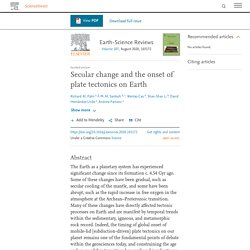
Some of these changes have been gradual, such as secular cooling of the mantle, and some have been abrupt, such as the rapid increase in free oxygen in the atmosphere at the Archean–Proterozoic transition. Many of these changes have directly affected tectonic processes on Earth and are manifest by temporal trends within the sedimentary, igneous, and metamorphic rock record. Indeed, the timing of global onset of mobile-lid (subduction-driven) plate tectonics on our planet remains one of the fundamental points of debate within the geosciences today, and constraining the age and cause of this transition has profound implications for understanding our own planet's long-term evolution, and that for other rocky bodies in our solar system.
Acts of geopoetry – understanding how we understand through plate tectonics – REflectED. I must admit, I am totally fascinated by plate tectonics.

Maybe it’s because, when we see images of the erupting volcano in Iceland, they photos look just so damned cool. Maybe it’s because in my home county of Co Antrim, shaped as it was by vast tectonic processes around 60 million years ago, there is evidence all around of the effects of volcanicity. Scene Viewer. Earth Learning Idea: What drives the plates? Modelling slab pull. The new ELI today is the last in our series of What drives the plates?
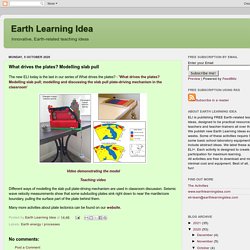
- 'What drives the plates? Modelling slab pull; modelling and discussing the slab pull plate-driving mechanism in the classroom' Where the lava flows: Volcano update from Iceland - Views of the WorldViews of the World. On 19.
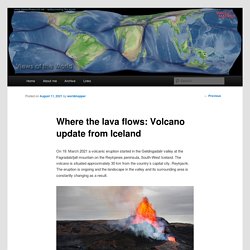
March 2021 a volcanic eruption started in the Geldingadalir valley at the Fagradalsfjall mountain on the Reykjanes peninsula, South-West Iceland. The volcano is situated approximately 30 km from the country’s capital city, Reykjavík. The eruption is ongoing and the landscape in the valley and its surrounding area is constantly changing as a result. (click for larger version) Here’s what makes earthquakes so devastating in Haiti. More than a decade after a powerful quake devastated Haiti in 2010, the region's complex geology has sent the island into yet another spate of deadly convulsions.

An intense magnitude 7.2 earthquake rocked Haiti in the morning hours of August 14, some 46 miles west of the 2010 temblor. Both quakes are part of Haiti’s long history of shakes, which results from the island nation’s position at the edge of the slowly shifting Caribbean plate. The movements build stresses in a network of fractures that crisscross the island, which occasionally release pent-up stress in ground-rattling earthquakes. While the region's quakes are not the most powerful in the world, their deadliness is magnified by Haiti's abundance of concrete and masonry buildings that were not built to withstand earthquakes. The full impacts from this latest event are not yet clear, but the quake likely wreaked havoc in communities that are already struggling from multiple pressures. Watch the waves from the M8.2 #Alaskaearthquake roll across seismic stations in North America. Earth's inner core is growing more on one side than the other – here’s why the planet isn't tipping.
More than 5,000 kilometres beneath us, Earth’s solid metal inner core wasn’t discovered until 1936.

Almost a century later, we’re still struggling to answer basic questions about when and how it first formed. These aren’t easy puzzles to solve. Youtube. Mid-Atlantic Ridge Volcanic Processes – Woods Hole Oceanographic Institution. Spring 1998 — On the islands of Iceland and Hawaii, the location and distribution of eruptive fissures and vents, lava flows, and other volcanic features provide critical pieces of information for understanding how magma is supplied to the shallow crust and subsequently erupted at the surface.
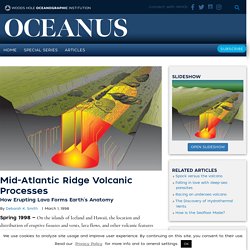
Mid-ocean ridge segments, which are in some ways single volcanoes—although long and narrow compared to subaerial (land) volcanoes—are not as well known, primarily because they lie at water depths of 2,500 meters or more. With advanced imaging techniques, we are, however, now obtaining data over relatively large areas of the mid-ocean ridges at the scales necessary to make the same kinds of observations and inferences about magmatic and volcanic processes there as we do at subaerial volcanoes.
Tourism development from disaster capitalism. Highlights Disaster capitalism is used for tourism development and creates more disasters.
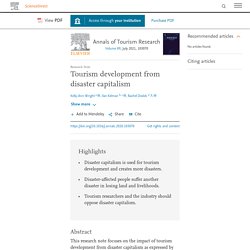
Disaster-affected people suffer another disaster in losing land and livelihoods. Tourism researchers and the industry should oppose disaster capitalism. Twitter. Royal Geographical Society - Geography resources for teachers. Haiti a long descent to hell Haiti The Guardian. Geochemists solve mystery of Earth's vanishing crust. Thank goodness for the Earth's crust: It is, after all, that solid, outermost layer of our planet that supports everything above it.

But much of what happens below that layer remains a mystery, including the fate of sections of crust that vanish back into the Earth. Now, a team of geochemists based at the Florida State University-headquartered National High Magnetic Field Laboratory has uncovered key clues about where those rocks have been hiding. Youtube. Acts of geopoetry – understanding how we understand through plate tectonics – REflectED. Youtube. Youtube. The Haiti earthquake - January 12, 2010. Quite simply, many buildings were not built with earthquakes in mind.
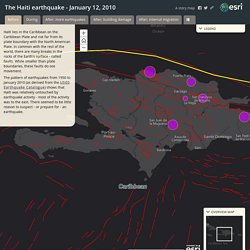
There are two reasons for this: 1) Earthquakes of this magnitude are very rare in this part of Haiti. 2) Haiti was at the time one of the poorer countries in the world - people could not afford to make buildings earthquake proof. The shaking was so powerful and buildings so weak, that collapse was inevitable in many - but not all - cases, as the photo below shows. The 'pancaking' of buildings - where the supporting walls were too weakly joined to the floor above - was a major cause of the very large numbers of fatalities.
Exploring the difference between shield & composite volcanoes. Japenese Earthquake and Tsunami 2011. Earthquakes Recovery and Reconstruction New Zealand. Icelandia. Geldingadalur graph analysis - Google Slides. The Geological Society. Skip Intro >> Background image: The weathered slopes of Snowdonia Choose a new background: 1 2 3 4 5 6 7 8. Untitled. (1126) Evolution of the eruption in Iceland Geldingadalir. Videos. This cool gif from @NOAA shows 200 million years of oceanic crust formation and the plate motion rate and direction. Earthquakes within the plates. Distribution of earthquakes (circles) having magnitudes greater than 2.5 and that occurred between 18th May to 18th June, 2021 along with tectonic plate boundaries (red).
The size of the circles correspond to the earthquake magnitude. Data from the USGS earthquake catalog at. What’s Most Remarkable About the Eruption. “One of the most remarkable things about this eruption is that there doesn’t seem to be any direct connection between the lava flow and the crater activity,” Þorvaldur Þórðarson, professor of volcanology at the University of Iceland, tells Morgunblaðið, speaking of the volcanic eruption by Fagradalsfjall mountain, Southwest Iceland.
“Once we start seeing a direct connection between the two, then changes in the crater activity can begin to tell us something about the overall behavior of the eruption.” Right now, though, that connection is missing. Þorvaldur explains that what controls the crater’s variable behavior (it has in recent days fluctuated from being very active to having next to no activity) is mainly changes in the top 100 meters (330 ft) of the volcanic conduit.
IRIS. Youtube.